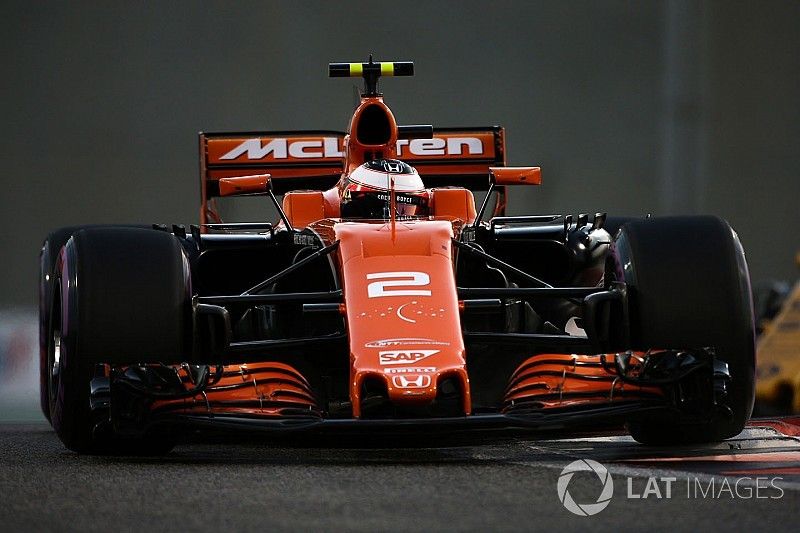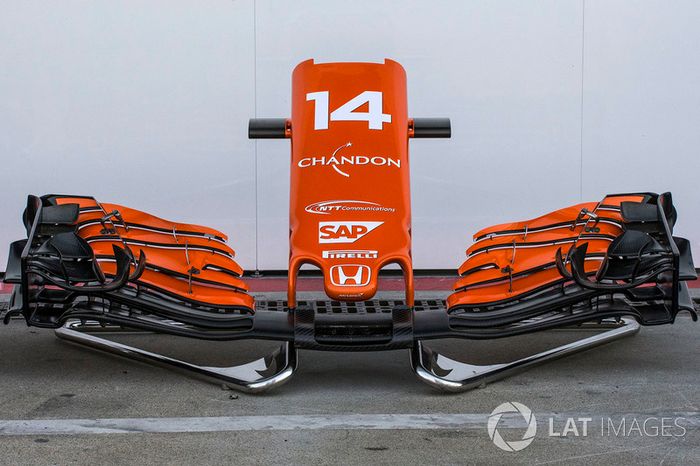Side view of the MCL32’s insanely complex rear wing endplates.
This shot from above illustrates the complexity of the MCL32’s midriff, with numerous slots cut into the bargeboards and footplates.
A close-up of the nose-mounted camera supports.
An extreme close-up of the complex and twisted front wing cascade.
The rear brake assembly during the build-up phase and without the associated brake drum fairings fitted. Note the carbon fibre shroud and pipework which helps cool the brake caliper.
The MCL32 with the covers off exposes layers of detail, such as the brake ducts, bulkhead and internal sidepod components.
The MCL32 while being worked on exposes much of the installation detail of the Honda power unit and its ancillary coolers.
A close-up of the MCL32’s steering wheel, showing the numerous buttons and rotaries that must be used by the driver to get the maximum from his power unit and chassis.
Cited upside down on the chassis we get the opportunity to see the clutch paddle arrangement favoured by Fernando Alonso, which uses a socket style adaptation in order that his fingers reside within the paddle and get a better feel for the clutch movement.
McLaren was one of the most active teams when it came to front wing optimisation throughout 2017 and kicked off their campaign with 5 changes to the front wing in Australia.
1 - an extra slot in the mainplane, 2 - two strakes running underneath the wing, rather than three, 3 - a revised footplate arc, 4 - revised shaping to the flap tips and 5 - a revised outer flap configuration.
Optimising flow around the sidepods the team made several revisions in Australia, with the upper surface of the bargeboard connecting winglet revised (red arrow), three vortex generators placed on the sidepods shoulder, rather than one (white arrow) and an extra axehead added to the floor (blue arrows).
McLaren introduced a long floor slot in China, similar to one already seen on the Toro Rosso, improving flow along the cars flank. The red arrow points to an almost imperceptible slot placed midway along the floor that ensures its compliance with the regulations.
The team introduced a T-wing in China, dubbed a ‘coat-hanger’ style due to its appearance. The winglet sought to generate its own downforce while also improving the behaviour of the rear wing, primarily through manipulation of the tip vortex. The complexity of the rear wing endplates is also drawn to your attention with the arrow.
Changes made to the already complex rear wing endplates on the MCL32 include a much longer pair of slots toward the rear of the surface and a revised leading edge (arrowed, left inset).
A look at the ever evolving front wing design, which now features three endplate canards and revisions to the main cascade.
The diffuser was updated in Spain to feature this vertical slot in the outer edge, injecting some of the high pressure flow from the upper surface into the outer section of the diffuser, affecting the edge vortex.
The bargeboards were a source of constant development throughout the season, with the slots in the footplate (arrowed) continually optimised.
This top down view of the MCL32 with Jenson Button at the wheel affords us a great viewpoint of the aero surfaces at the front of the car. Note also the use of asymmetric cooling panels beside the driver, with eight louvres in the right panel and none in the left.
McLaren joined a growing pool of teams to employ rearward facing gurney extensions that reach back behind the diffuser, with the intent of revising the edge vortex.
Kiel probe arrays are mounted ahead of the sidepods as the team looks to gather data on the airflows movement around the midriff of the car, with updates to the bargeboards and surrounding aerodynamic paraphernalia made in Monaco.
In order to help quell the effects of ‘tyre squirt’ the team added three slots into the floor ahead of the rear tyre.
A look at the changes made to the front wings flap tips for the Canadian GP, as a much more extreme curvature was employed.
A revised cascade layout was introduced in Austria, featuring its own mounting support next to the main endplate and revised geometries to the outer, vertical fences.
The front wing in Hungary utilised a gurney trim on the uppermost flap in order to add a little more front end and balance it with the gains made at the rear of the car.
Comparison of the new and old monkey seats, the new one (left inset) featuring a longer mounting spar and revised arch to the winglet, as the designers look to improve the shape of the plume exiting the exhaust.
McLaren’s high-downforce, triple element T-wing.
Lando Norris at the wheel of the MCL32 which is outfitted with a kiel probe array between the front wheel and sidepod, evaluating the wake generated by the front wheel.
Close-up of the bargeboards footplate which had extra slots added into it in the preceding races.
Just two louvres to displace heat generated within the sidepods in the cooling panel used in Belgium.
Lower downforce rear wing with semi-spoon shaping utilised in conjunction with the monkey seat and coat-hanger style T-wing.
Front wings upper flap cut down dramatically for Monza to reduce drag and mimic downforce levels at the rear of the car.
Low-downforce rear wing for the Italian GP with no T-wing in use either.
Chassis/bulkhead, suspension and brake cylinder detail.
A pre-bargeboard was added to this already busy looking area of the car (arrowed).
A look at the ever increasing complexity of the region between the front wheels and sidepods, occupied by a collection of bargeboards and floor extensions.
A rearward shot of the front wing and nosecone assembly shows many of the details that ordinarily remain out of sight.
A view inside the MCL32’s cockpit. Note the huge array of buttons and rotaries on the steering wheel, all of which are used by the driver to control the various parameters of the car and power unit.
An all too familiar sight in 2017 as the RA617H Honda power unit is detached from the MCL32 for investigative work. In doing so though, it gives us an opportunity to see the installation.
The MCL32’s front brake duct assembly utilises a sizeable ‘crossover’ pipe which draws air in through the main brake scoop with the intent of ejecting it through the wheel face.
The MCL32’s rear brake duct assembly manages the temperature relationship between the brakes and the rear wheel rims. Also note the significant quantity of winglets mounted on the inside of the vertical fence.
Fernando Alonso at the wheel of his MCL32. Note the use of four cooling outlets in the panel next to the cockpit.
In contrast, here’s the MCL32 set-up with an eight-louvre cooling panel.
Overhead shot of the front wing specification first introduced in the United States that features an additional slot in the mainplane.
Vandoorne at the wheel of his MCL32, note that only three louvres are in use in the cooling panel aside the cockpit.

































































Top Comments